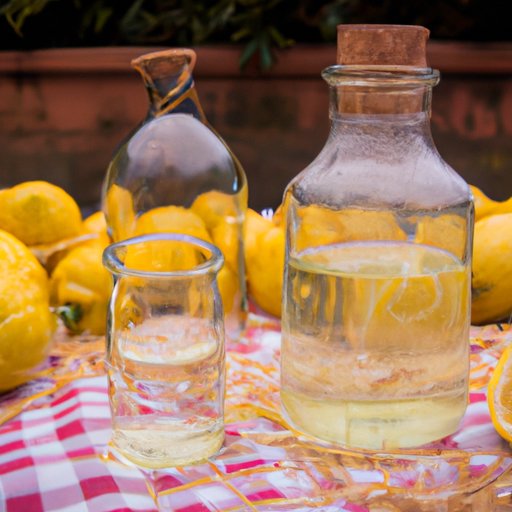Introduction
If you’re a fan of Italian cuisine, chances are you’ve heard of limoncello. This lemon-flavored liqueur hails from the southern coast of Italy and is typically served chilled as an after-dinner digestive. While you can find limoncello commercially produced all over the world, there’s something special about crafting your own version of this invigorating drink. In this article, we’ll provide a comprehensive guide to making homemade limoncello that will rival the best Italian versions.
Step-by-Step Guide: Making Homemade Limoncello with Fresh Lemon Peels
Before delving into the art of crafting limoncello, let’s take a closer look at the ingredients and method required to make it. Here’s what you’ll need:
- 1 750 ml bottle of high-proof vodka or grain alcohol
- 10-12 fresh, organic lemons
- 2 cups of sugar
- 3 cups of water
- A large, sealable jar or bottle
Begin by washing your lemons thoroughly and peeling them with a vegetable peeler, being careful to avoid the pith (white part). Pith can impart a bitter taste and will cloud your finished product. Place the lemon peels in your jar or bottle and add the alcohol. Seal the container tightly and let it steep for at least a week in a dark, cool place.
Once the mixture has steeped sufficiently, you’ll need to make a simple syrup by heating the sugar and water together until the sugar has dissolved completely. Allow the syrup to cool, then strain your lemon/alcohol mixture through a fine mesh strainer or cheesecloth and add the syrup to it.
When you’ve combined all your ingredients, seal the container tightly and let the liqueur age for at least a week before serving. Store it in the freezer and serve it straight in small chilled glasses or use as a base for cocktails.
The Art of Crafting Limoncello: Tips and Tricks to Achieving the Perfect Flavor
While the basic recipe for limoncello is simple enough, you may still need some help achieving the perfect flavor. Here are some tips from seasoned limoncello makers to help you get it just right:
- Select the right type of lemons: Eureka and Lisbon lemons are often used in commercial limoncello, but if you can find them, Sorrento or Amalfi lemons are considered the ideal.
- Choose the appropriate alcohol: You’ll need a high-proof, neutral alcohol such as vodka or grain alcohol (everclear). Don’t be tempted to use lower-proof alternatives – they may not produce a strong enough flavor.
- Steeping times: While the traditional steeping time for limoncello citron is 80 days, you can make sufficient limoncello after a steeping period of one week.
- Temperature and light: Limoncello should be steeped in a cool, dark place to avoid potential issues like spoilage or the development of off-flavors.
Using Organic Lemons to Create a Refreshing DIY Limoncello
When it comes to selecting the best lemons for your limoncello, using organic is always a good idea. Not only are you avoiding potential contaminants and pesticides, but organic lemons also have more natural oils, which is crucial for a quality limoncello.
If you can’t find organic lemons in your supermarket, check out farmer’s markets or specialty food stores. Your best bet may be ordering online, where you’re likely to find a year-round supply of organic lemons.
Secrets of the Trade: Insider Tips from Italian Homemade Limoncello Artisans
Wondering how to achieve the distinctive flavor of limoncello you’ve tasted in Italy? Here are some insider secrets from the professionals themselves:
- Make your limoncello without any shortcuts or preservatives, using only natural ingredients
- Use only the bright yellow part of your lemon peels
- Give your limoncello a modern twist by experimenting with different flavorings like ginger or almond essence
- Ensure that the alcohol percentage of your limoncello remains high. This makes sure that it is antiseptic for a longer time, and more importantly, it helps enhance the flavour of the drink
From Italy to Your Home: The Secrets of Making Authentic Limoncello
Limoncello has been a favorite in Italy for generations, and families often have their closely guarded recipes handed down through the years. But you don’t have to hail from the southern coast of Italy to create stellar, authentic limoncello yourself. Using fresh, quality ingredients, taking the time to steep the lemon peels, and aging the final product properly are all key factors in producing a high-quality, artisanal limoncello.
To truly enjoy limoncello like an Italian, serve it very cold in small, ice-cold glasses after dinner. This liqueur is not meant to be gulped but should be sipped slowly to allow the full complexity of the flavor to be appreciated.
Limoncello for Beginners: A Foolproof Recipe and Guide to Impress Your Friends and Family
If you’re new to the world of limoncello-making, don’t worry – you can create a simple, satisfying version with just a few key ingredients.
Here’s a recipe that’s perfect for beginners:
- 1 750 mL bottle of vodka
- 10-12 fresh, organic lemons, peeled
- 2 cups of sugar
- 3 cups of water
In a large, sealable jar or bottle, combine the lemon peels and alcohol, then seal tightly and let it steep for a week in a cool, dark place. After the week has passed, make a simple syrup by heating the sugar and water together until the sugar has dissolved completely. Allow the syrup to cool, then add it to your lemon/alcohol mixture. After mixing, strain your limoncello and let it age for a week before serving chilled.
Conclusion
Making limoncello at home may seem daunting at first, but with the right ingredients, some patience, and a bit of practice, you can create a limoncello that rivals the best Italian versions. By following the tips and tricks outlined in this guide, you’ll be able to craft an authentic, artisanal limoncello that will impress friends, family, and your tastebuds.
